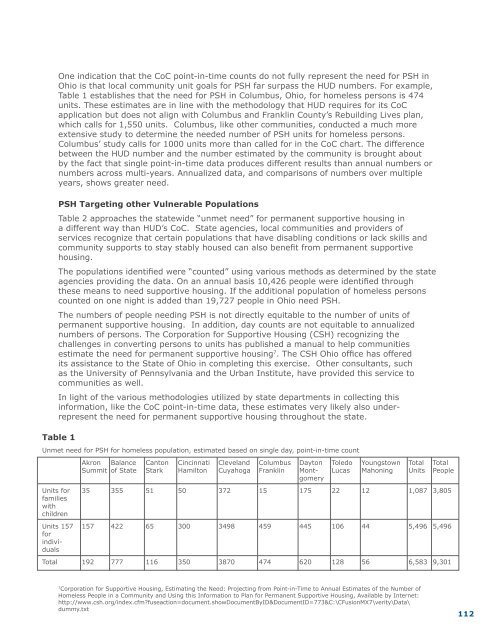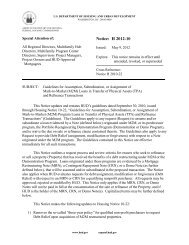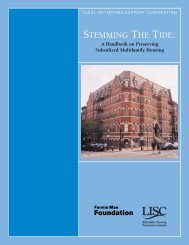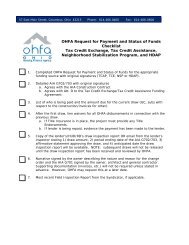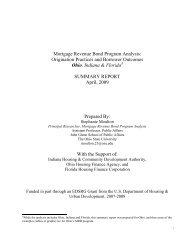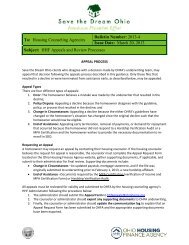OHFA Annual Plan - Ohio Housing Finance Agency
OHFA Annual Plan - Ohio Housing Finance Agency
OHFA Annual Plan - Ohio Housing Finance Agency
Create successful ePaper yourself
Turn your PDF publications into a flip-book with our unique Google optimized e-Paper software.
One indication that the CoC point-in-time counts do not fully represent the need for PSH in<strong>Ohio</strong> is that local community unit goals for PSH far surpass the HUD numbers. For example,Table 1 establishes that the need for PSH in Columbus, <strong>Ohio</strong>, for homeless persons is 474units. These estimates are in line with the methodology that HUD requires for its CoCapplication but does not align with Columbus and Franklin County’s Rebuilding Lives plan,which calls for 1,550 units. Columbus, like other communities, conducted a much moreextensive study to determine the needed number of PSH units for homeless persons.Columbus’ study calls for 1000 units more than called for in the CoC chart. The differencebetween the HUD number and the number estimated by the community is brought aboutby the fact that single point-in-time data produces different results than annual numbers ornumbers across multi-years. <strong>Annual</strong>ized data, and comparisons of numbers over multipleyears, shows greater need.PSH Targeting other Vulnerable PopulationsTable 2 approaches the statewide “unmet need” for permanent supportive housing ina different way than HUD’s CoC. State agencies, local communities and providers ofservices recognize that certain populations that have disabling conditions or lack skills andcommunity supports to stay stably housed can also benefit from permanent supportivehousing.The populations identified were “counted” using various methods as determined by the stateagencies providing the data. On an annual basis 10,426 people were identified throughthese means to need supportive housing. If the additional population of homeless personscounted on one night is added than 19,727 people in <strong>Ohio</strong> need PSH.The numbers of people needing PSH is not directly equitable to the number of units ofpermanent supportive housing. In addition, day counts are not equitable to annualizednumbers of persons. The Corporation for Supportive <strong>Housing</strong> (CSH) recognizing thechallenges in converting persons to units has published a manual to help communitiesestimate the need for permanent supportive housing 7 . The CSH <strong>Ohio</strong> office has offeredits assistance to the State of <strong>Ohio</strong> in completing this exercise. Other consultants, suchas the University of Pennsylvania and the Urban Institute, have provided this service tocommunities as well.In light of the various methodologies utilized by state departments in collecting thisinformation, like the CoC point-in-time data, these estimates very likely also underrepresentthe need for permanent supportive housing throughout the state.Table 1Unmet need for PSH for homeless population, estimated based on single day, point-in-time countAkron Balance Canton Cincinnati Cleveland Columbus Dayton Toledo Youngstown Total TotalSummit of State Stark Hamilton Cuyahoga Franklin Mont- Lucas Mahoning Units PeoplegomeryUnits for 35 355 51 50 372 15 175 22 12 1,087 3,805familieswithchildrenUnits 157 157 422 65 300 3498 459 445 106 44 5,496 5,496forindividualsTotal 192 777 116 350 3870 474 620 128 56 6,583 9,3017Corporation for Supportive <strong>Housing</strong>, Estimating the Need: Projecting from Point-in-Time to <strong>Annual</strong> Estimates of the Number ofHomeless People in a Community and Using this Information to <strong>Plan</strong> for Permanent Supportive <strong>Housing</strong>, Available by Internet:http://www.csh.org/index.cfm?fuseaction=document.showDocumentByID&DocumentID=773&C:\CFusionMX7\verity\Data\dummy.txt112


